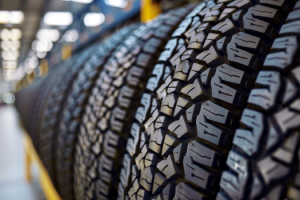Last Updated on June 7, 2024
Introduction to Tire Lifecycle Management
Welcome to “Tires Easy Truck,” where our commitment extends beyond providing quality tires to addressing the environmental responsibilities of tire lifecycle management. This section introduces the purpose of our comprehensive document and outlines the life cycle of a tire, emphasizing the importance of each phase in contributing to sustainability.
Purpose of the Guide
The purpose of this guide is to serve as an authoritative guide for the responsible management of truck tires from their production to their final disposal or reincarnation through recycling and upcycling processes. Here is the purpose of this guide:
- Educational Tool: We aim to educate our readers, from fleet managers to individual truck operators, about the significance of each stage in a tire’s life cycle and its environmental implications.
- Resource for Best Practices: This guide provides insights into best practices for extending tire life, responsible disposal, and innovative reuse and recycling methods.
- Sustainability Advocate: By informing and guiding stakeholders in the trucking industry, we support the movement towards a more sustainable and environmentally conscious approach to tire lifecycle management.
The Life Cycle of a Tire
The life cycle of a tire encompasses various stages, each with its environmental and economic impacts, especially within the trucking industry. Here is the life cycle of a tire:
- Manufacturing: The process begins with the manufacturing of tires, which involves the extraction and processing of raw materials, such as rubber, carbon black, steel, and chemicals. The design and production methods affect the tire’s durability and recyclability.
- Usage: Once fitted to vehicles, tires enter the usage phase. The lifespan of a truck tire depends on several factors, including driving conditions, tire maintenance, and driving habits. Proper maintenance can significantly extend a tire’s useful life.
- Replacement and Retreading: Worn tires are either replaced or, when suitable, retreaded. Retreading is a practice that replaces the worn tread on a tire casing with a new tread, extending the tire’s service life.
- Collection and Processing: End-of-life tires are collected and processed. This phase is critical as it determines whether a tire will be disposed of, recycled, or repurposed.
- Recycling and Upcycling: At this stage, tires can be transformed into new materials or products through recycling or creative upcycling, thus starting an unknown lifecycle and minimizing environmental waste.
- Disposal: Finally, tires unsuitable for recycling or retreading must be disposed of properly to prevent environmental harm.
Understanding a tire’s life cycle is crucial for adopting practices that can reduce environmental impact and promote sustainability. At Tires Easy Truck, we encourage our readers to participate actively in responsible tire lifecycle management, contributing to a healthier planet and a more sustainable future.
Collection and Initial Processing
The proper disposal and recycling of tires is a significant environmental concern, as improper tire disposal can lead to toxic leachates, provide breeding grounds for pests, and create fire hazards. The first step in managing end-of-life tires is their collection, sorting, and initial processing.
Tire Collection Points
Tire collection points are the initial stage in the journey of a tire from use to reuse or recycling. These collection points are typically established where tires are replaced:
- Automotive Shops: Most tire replacements occur at automotive service centers, where the old tires are collected and stored temporarily.
- Retail Outlets: Tire retail outlets often provide disposal services for old tires when new ones are purchased.
- Recycling Centers: Designated recycling centers serve as drop-off points for consumers and businesses with tires that need disposal.
- Special Collection Events: Some municipalities or environmental organizations host collection events for tires and other hazardous waste.
These points must comply with local regulations regarding storage to prevent environmental damage and reduce fire risks.
Sorting and Transportation
Once tires have been collected, they must be sorted and transported to facilities where they can be processed further:
- Sorting: Tires are sorted based on their condition, size, and type. Tires suitable for retreading are separated from those that are not.
- Transportation: After sorting, tires are transported to processing facilities. This step is crucial because improper transit can lead to road hazards or environmental pollution.
- Logistics: The logistics of tire transportation must be managed efficiently to minimize costs and environmental impact. This often requires specialized vehicles and routes.
Initial Inspection and Categorization
At the processing facility, an initial inspection and categorization process takes place:
- Inspection: Each tire is inspected to assess its condition. Factors such as tread depth, structural integrity, and overall wear are evaluated.
- Categorization: Tires are categorized based on the inspection. Categories typically include tires for retreading, recycling, energy recovery, or, worst case, landfilling.
- Tracking: Tires must be tracked through the disposal process to ensure they are disposed of responsibly. Some regions have tracking systems in place to prevent illegal dumping.
- Regulatory Compliance: All tires must be processed in compliance with local and national regulations to ensure environmental protection.
The initial phase of collection and processing is essential in setting the stage for the sustainable management of tire waste. It ensures that tires are correctly handled to maximize their potential for material recovery and minimize their environmental impact. The processes are designed to facilitate the transition of tires from merely waste to becoming valuable resources for various industries.
Recycling Methods
Recycling old tires is necessary for environmental protection and resource conservation. Various methods are employed to recover materials and energy from tires and utilize them in civil engineering applications.
Material Recovery
Material recovery involves reclaiming specific materials from the tires, which can be reused or repurposed. The process involves:
- Rubber: Tires can be recycled by grinding down the rubber into crumb rubber, which can be used for various purposes. Crumb rubber can be incorporated into playground surfaces and athletic tracks. It can also be used as an additive in new tires or rubber products.
The process of grinding down tires must be thorough to ensure the removal of other materials and to produce rubber of a suitable size and purity for its intended use.
- Steel: Many tires contain steel belts that can be extracted during recycling. The reclaimed steel can be melted down and repurposed in various industries, including automotive and construction. The extraction is often done using powerful magnets after shredding the rubber.
- Fiber: Tires also contain synthetic and natural fibers, which can be extracted and used in insulation or filler material applications. These fibers need to be separated from the other materials, which can be challenging due to their entanglement with rubber and steel.
Energy Recovery
Energy recovery from tires is another recycling method that can help to reduce fossil fuel use. The process involves:
- Tire-Derived Fuel (TDF): TDF is created by shredding old tires and using them to supplement traditional fuels in facilities such as cement kilns, paper mills, and power plants. TDF is a high-energy-content fuel, and its use can reduce emissions compared to some types of coal, though emissions of other pollutants may increase.
- Pyrolysis: This process involves heating tires without oxygen, which breaks them down into oil, gas, and char. The oil can be refined and used as a fuel or feedstock to produce new synthetic rubber. The gas can generate electricity, and the char can be used as a carbon black substitute or for soil amendment.
Civil Engineering Applications
Recycled tire materials are also used in civil engineering applications due to their durability and resilience. They can be used as:
- Asphalt Additive: Crumb rubber from tires can be mixed with asphalt to create rubberized asphalt used in road construction. This type of asphalt has improved durability and noise reduction properties compared to traditional asphalt.
- Construction Material: Tire chips can be used as a lightweight aggregate in construction materials like concrete and for backfill in construction projects. Their use can enhance the insulating properties and drainage capabilities of construction materials.
The comprehensive recycling of tires is an ongoing challenge due to the materials involved and the sheer volume of tires discarded annually. However, advancements in recycling technology and methods continue to improve the efficiency and effectiveness of this process, offering more sustainable solutions for tire waste management.
Reuse and Upcycling of Truck Tires
In tire management, reuse and upcycling present innovative solutions to reduce waste and contribute to a sustainable environment. We will explore the various avenues through which the life of truck tires can be extended beyond their initial purpose on the road.
Tire Retreading
Tire retreading is a process that allows truck tires to be used beyond their original tread life by applying new tread to the existing casing. This process extends the tire’s life and offers economic and environmental benefits.
- Retreading Process: Retreading truck tires involves inspecting and repairing the used tire casings, buffing away the remaining old tread, and applying new tread through a specialized process involving heat and pressure.
- Quality Assurance: Retreaded tires are subject to rigorous testing to meet safety standards. When performed correctly, retreaded tires are nearly as durable and reliable as new tires.
- Environmental Benefits: Manufacturing a new truck tire has a significant ecological impact. Retreading tires uses substantially less oil and other resources than producing a new tire, conserving natural resources and reducing the carbon footprint.
Creative Reuse
Beyond retreading, truck tires can find new life through creative reuse, which not only diverts tires from landfills but also taps into the innovative potential of upcycling.
- Furniture: Due to their large size and durability, truck tires are excellent materials for creating robust and weather-resistant furniture. With creative design, tires can be transformed into tables, chairs, and outdoor seating solutions.
- Garden Containers: Upcycled truck tires can be used to create large, sturdy containers for gardening. They are handy for raised beds, offering a controlled environment for plant growth and adding an aesthetic appeal to garden spaces.
- Art Projects: Truck tires’ scale and texture provide a unique medium for large-scale art installations and community projects. Artists can manipulate, cut, paint, and combine tires to create sculptures and interactive pieces that convey sustainability and innovation.
We encourage exploring these environmentally friendly practices. Retreading and creative reuse are cost-effective and align with the global movement toward sustainability.
They represent a commitment to reducing waste and promoting a circular economy where products are kept in use for as long as possible. Truck tires can continue to provide value in new and unexpected ways through reuse and upcycling.
Environmental Impact
Tire disposal and recycling have significant environmental implications. Handling old tires can contribute to environmental sustainability or pose serious hazards.
Benefits of Recycling and Reuse
Recycling and reusing tires offer numerous environmental benefits that contribute to resource conservation and waste reduction, such as:
- Conservation of Resources: Recycling tires conserves natural resources by reducing the need for new raw materials, such as rubber and oil. For every ton of recycled rubber, a significant amount of oil is conserved in the production of synthetic rubber.
- Reduction in Greenhouse Gas Emissions: By repurposing tires into new products or alternative energy sources, greenhouse gas emissions from producing new materials and burning fossil fuels are reduced.
- Waste Reduction: Recycling and reusing tires divert them from landfills and the environment, minimizing the waste footprint. Tires can take up significant space in landfills and do not biodegrade quickly.
- Pollution Prevention: Proper tire recycling helps prevent pollution by reducing illegal dumping, which can lead to water and soil contamination from the chemicals and heavy metals in tires.
Potential Hazards
If not appropriately managed, tire waste can pose environmental and health hazards, including:
- Leaching of Chemicals: Tires contain chemicals and heavy metals that can leach into the soil and groundwater, mainly when tires are improperly disposed of in landfills or illegal dumping sites. These contaminants can be harmful to wildlife and human health.
- Fire Risks: Tire stockpiles can create significant fire hazards. Tire fires are difficult to extinguish and can burn for extended periods, releasing toxic smoke and pollutants into the air. The runoff from tire fires can also contaminate the soil and water sources.
The environmental impact of tire waste management is a balancing act between harnessing the benefits of recycling and reuse and mitigating the potential hazards associated with tire disposal.
Proper regulations, innovative recycling methods, and public awareness are crucial to ensuring that tires have a minimal negative environmental impact. By recognizing the value of end-of-life tires as a resource rather than waste, we can make strides toward a more sustainable future.
Policies and Regulations for Tire Disposal in the Trucking Industry
Tire disposal, particularly in the trucking industry, is subject to complex rules and regulations. These rules are designed to ensure environmental safety, sustainable practices, and the responsible handling of tire waste.
International Standards
On an international level, standards for tire disposal aim to harmonize practices across borders and ensure that tire waste is managed in an environmentally sound manner. Here are some international standards:
- Basel Convention: The Basel Convention on the Control of Transboundary Movements of Hazardous Wastes and Their Disposal includes tires in its scope. It requires that the export and import of tire waste for recovery or disposal be controlled and carried out only with the consent of the receiving country.
- ISO Standards: ISO standards relevant to tire disposal include ISO 14001 for environmental management systems, which guides tire recycling plants in minimizing their environmental impact. It also has ISO 26000, which outlines the principles of social responsibility, encouraging businesses to act ethically in their waste management practices.
National and Local Regulations
National and local regulations regarding tire disposal can vary, but they typically cover the following areas:
- Tire Disposal Acts: Many countries have specific legislation that directs the proper disposal of tires, sometimes including a tax on new tires that funds tire recycling programs.
- Extended Producer Responsibility (EPR): Under EPR policies, tire manufacturers and sellers may be required to manage the disposal of end-of-life tires. This could include collecting and recycling tires when they end their useful life.
- Transport and Storage Regulations: There are often strict rules about how tires must be transported and stored to prevent environmental contamination and reduce the risk of fires.
- Local Ordinances: Municipal regulations might dictate the number of tires that can be stored at a facility, the necessity of a permit to transport tire waste, or the requirements for a business to provide tire recycling services.
Compliance and Enforcement
Ensuring compliance with tire disposal regulations is necessary for public health and environmental protection. Here are some ways to provide such compliances:
- Inspections and Audits: Trucking businesses can expect regular inspections and audits to ensure that their tire disposal practices comply with the relevant regulations.
- Penalties: Non-compliance can result in significant fines, legal sanctions, and reputational damage. These punitive measures incentivize companies to follow the regulations.
- Education and Training: Regulators often provide educational resources and training programs to help businesses understand and comply with tire disposal regulations.
- Tracking Systems: To enforce compliance, some jurisdictions have implemented tracking systems for tire waste, ensuring that tires are disposed of properly from the point of collection to their final destination.
“Tires Easy Truck” emphasizes the importance of understanding and following these international and national regulations, advocating for compliance as a legal obligation and a commitment to environmental stewardship and corporate responsibility. Through rigorous adherence to these policies and regulations, the trucking industry can contribute to a cleaner and more sustainable future.
Future of Tire Disposal for the Trucking Industry
The commercial trucking industry faces unique challenges and opportunities regarding tire disposal. With the growing emphasis on sustainability and environmental responsibility, the future of tire disposal is evolving rapidly. This section will explore the latest advancements and trends shaping this transformation.
Innovations in Recycling Technology
The future of truck tire recycling is being reshaped by technological innovations designed to enhance efficiency and environmental compatibility.
- High-Efficiency Pyrolysis: Advanced pyrolysis processes are being developed specifically for truck tires, which are substantially more significant and durable than passenger vehicle tires. These processes maximize the recovery of valuable materials like high-quality oil, carbon black, and steel while minimizing energy consumption.
- Breakthroughs in Truck Tire Devulcanization: Devulcanization technology is witnessing significant improvements. It enables the recycling of truck tires into reusable rubber without compromising the material’s quality. This rubber can then be used to produce new truck tires, reducing the demand for virgin raw materials.
- Enhanced Material Recovery: Innovations in separation and material recovery technologies are enabling more efficient recovery of materials from truck tires. This includes more advanced shredding techniques that can handle the extensive construction of truck tires, allowing for the extraction of cleaner rubber, fiber, and metal components.
- Cryogenic Grinding: The trucking industry is looking at advancements in cryogenic grinding, which uses liquid nitrogen to freeze tires before they are pulverized. This method is particularly effective for processing the tough rubber compounds in truck tires, resulting in finer rubber particles suitable for high-grade applications.
Sustainable Manufacturing
Sustainable manufacturing processes are becoming increasingly important in the production of truck tires. Here are some ways sustainable manufacturing is beneficial:
- Eco-Friendly Materials: Truck tire manufacturers are exploring using sustainable materials, such as bio-based rubbers and environmentally friendly fillers, to reduce their products’ ecological footprint.
- Life Cycle Analysis: By implementing life cycle analyses, manufacturers can better understand and minimize the environmental impacts of truck tires throughout their life span, from the procurement of raw materials to the manufacturing process, usage, and end-of-life disposal.
- Designing Long-Lasting Tires: The industry focuses on creating more durable truck tires that are easier to retread, which can significantly extend the tire’s life and reduce waste.
- Retreading: Retreading is a cornerstone of sustainable manufacturing in the trucking industry. It is a process where worn tires are refurbished with new treads, making them as reliable as new tires. This not only conserves resources but also reduces the tire disposal volume.
Market Trends and Consumer Behavior
Market trends and consumer behavior influence the adoption of sustainable tire disposal practices in the following ways:
- Demand for Recycled Products: The trucking industry is experiencing a growing demand for products made from recycled tire materials. This market pressure encourages investment in recycling infrastructure and innovation.
- Environmental Regulations: Stringent environmental regulations are prompting the trucking industry to adopt more sustainable tire disposal practices. Companies are increasingly held accountable for the disposal of their tire waste, leading to more responsible management strategies.
- Circular Economy: The circular economy is gaining popularity in the trucking industry. There is an increasing focus on designing tires and business models that facilitate reuse and recycling, reduce waste, and conserve resources.
- Product Stewardship: Truck tire manufacturers are encouraged to take greater responsibility for their products throughout their life cycle. This includes offering tire take-back schemes and recycling programs.
- Education: A concerted effort is to educate trucking professionals about sustainable tire disposal practices. Knowledge sharing on the benefits and methods of tire recycling can lead to broader adoption of best practices across the industry.
The commercial trucking industry is on the verge of a new era in tire disposal, marked by innovation, sustainable practices, and a shift towards a more circular economy. “Tires Easy Truck” is committed to being at the forefront of this change, supporting and informing our customers and partners about the best practices for tire disposal and recycling.
List of Tire Recycling Facilities
The trucking industry needs to be environmentally friendly, and tire recycling facilities play a big part in this. These facilities are at the forefront of turning old tires into valuable materials, which helps the circular economy and reduces tire waste’s ecological footprint.
Tire recycling facilities use advanced technology to recover materials such as rubber, steel, and fiber from old tires. They often specialize in creating specific products or raw materials for further manufacturing processes. These facilities are spread across various regions to provide accessible services to fleets and individual truck owners alike.
While a comprehensive list of tire recycling facilities would be too extensive for this format and continually evolving, here are general pointers to help you locate tire recycling services:
- Local Directories: Many regions offer directories of authorized tire recyclers, which can be found through municipal or environmental agency websites. These directories often provide detailed information, including the types of tires accepted and the recycling processes used.
- Industry Associations: Associations such as the Tire Industry Association (TIA) and the Institute of Scrap Recycling Industries (ISRI) maintain resources that help locate recycling facilities. They offer networks and partnerships that support the tire recycling industry.
- Online Resources: Websites like Earth911 provide searchable databases where you can find local recycling centers based on your ZIP code, including those that accept truck tires.
- State and Provincial Programs: In some areas, state or provincial environmental programs can provide lists of tire recycling facilities as part of their waste management services.
- Tire Retailers: Some tire retailers may partner with recycling facilities and can either take back your used tires for recycling or direct you to the nearest recycling centers.
- Manufacturer Take-Back Schemes: Certain tire manufacturers offer take-back programs that accept used tires and ensure they are sent to recycling facilities. This can be part of extended producer responsibility initiatives.
It is always recommended to call ahead and confirm the acceptance policies, as some facilities may have specific requirements or charge a fee for recycling services.
“Tires Easy Truck” supports the tire recycling industry by encouraging our customers to take advantage of these facilities. By ensuring your used tires are handled by reputable recyclers, you reduce environmental waste and support the creation of recycled tire products.
Please visit our website for assistance finding a tire recycling facility or learning more about sustainable tire practices. We are here to help guide you through responsible tire disposal.
Conclusion & Recommendations
Our comprehensive guide on tire lifecycle management reveals that the journey of a tire extends far beyond its initial purpose on the road. Tire disposal and recycling significantly impact the environment, with the trucking industry playing a huge role due to the large number and size of truck tires.
Innovations in recycling technology shifts towards sustainable manufacturing and changes in market trends and consumer behavior have all underscored the importance of responsible tire disposal. Tire retreading has become a meaningful way to make truck tires last longer, while creative reuse and upcycling are new ways to protect the environment.
Recommendations for Consumers
For consumers in the trucking industry, the path forward involves several key actions. Here are some things to act on:
- Prioritize purchasing tires from manufacturers that demonstrate a commitment to sustainability.
- Engage in regular tire maintenance to extend their life and ensure road safety.
- When it’s time for disposal, choose recycling or retreading options over landfilling.
- Stay informed about the latest regulations and standards to ensure compliance and contribute to a more sustainable industry.
Closing Thoughts
Manufacturers, consumers, and policymakers share the responsibility for a sustainable future in tire lifecycle management. An ongoing commitment to innovation, education, and conscious decision-making will drive the industry towards a greener horizon.
In line with our findings and recommendations, “Tires Easy Truck” invites you to explore our selection of sustainable tire options. We are committed to providing products that meet the highest performance and safety standards and contribute to the well-being of our environment.
Join us in this journey towards sustainability. Please browse our selection, benefit from our expertise, and make your next tire purchase a step in the right direction for our planet.
FAQs
What can you do with old tires?
Old tires can be repurposed in several ways: retreaded for continued use on vehicles, recycled into rubber products like mulch or playground surfaces, or creatively upcycled into furniture, garden containers, or art projects.
What cannot be placed in a dumpster?
Generally, hazardous materials, flammable liquids, toxic substances, batteries, paint, and tires should not be placed in dumpsters due to potential environmental hazards and local regulations that require unique disposal methods.
How is a tire disposed of?
A tire is disposed of by being taken to a recycling facility. There, it can be processed to recover rubber, steel, and textile fibers or repurposed entirely for energy recovery or civil engineering projects.
Can tires be recycled instead of thrown out?
Yes, tires can and should be recycled instead of thrown out. Recycling tires helps conserve resources, reduce landfill waste, and create various useful products, from rubber mats to construction materials.
Where can I take my old truck tires for recycling?
You can take your old truck tires to local tire recycling facilities, which can often be found through online directories, tire retailers, or by contacting local waste management authorities.
Are there any fees associated with tire recycling?
Some tire recycling centers may charge a fee to cover the costs of the recycling process. This fee can vary depending on the location and facility.
What products are made from recycled truck tires?
Recycled truck tires can be transformed into various products, including rubber mulch for landscaping, rubberized asphalt for roadways, and crumb rubber for athletic fields and playgrounds.
How does tire recycling benefit the environment?
Tire recycling helps conserve natural resources, reduces pollution from tire fires, and minimizes landfill space, contributing to a healthier environment.
How are my old tires suitable for retreading?
Professionals at retreading facilities typically inspect tires suitable for retreading to assess their condition and determine if they can be safely retreaded.










